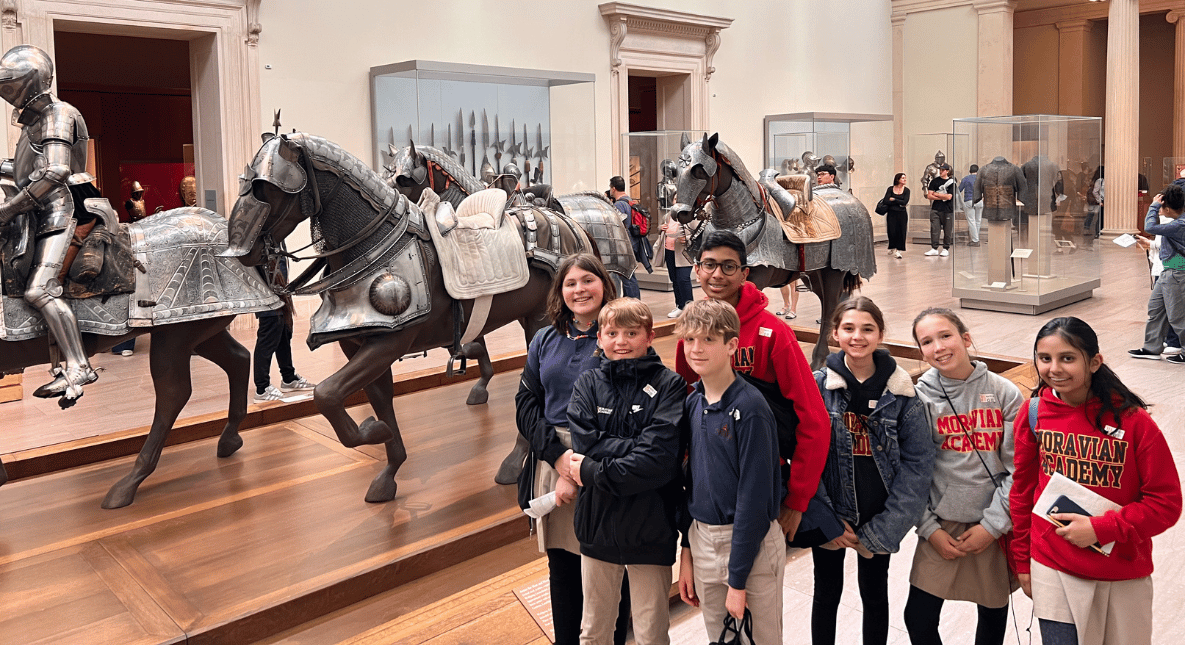Class of 2027 Holds Mock Climate Summit
On Thursday, May 10, Moravian Academy’s freshman class engaged in a simulated climate summit as a culminating project in the World History I Sustainability Unit. Their one goal: to prevent the global temperature increase from surpassing 2° Celsius!
The ninth graders were split into six different groups, each representing a different country, union, or alliance, including China, India, the European Union, other developed nations, developing nations, and the US Climate Alliance. In addition, three students played as climate activists, and the remaining three were climate journalists.

The climate summit was organized into three rounds of negotiations, in which the six groups of representatives debated with each other to modify their peak emissions year, reductions year, reduction rate, prevention of deforestation rate, and promotion of afforestation rate. The journalists all monitored and recorded the heated interactions between the different nations, recording and interviewing individuals to get a sense of their feelings and opinions of the current negotiations. All of the countries stated their enemies, allies, how climate change is affecting them, what they are doing to mitigate climate change, what outcome they would like to see, and what negotiating powers they possess. In order to answer these questions, the ninth graders researched their region or role in their World History classes, and followed Brown University’s Climate Change curriculum to grasp a basic understanding of the drastic effects climate change has on every aspect of our world.
After the first round of negotiations, the ninth graders decreased the global temperature increase to 2.4° C, which is a significant improvement compared to the original 4.3°C increase. Despite this good news, they learned that the sea levels were still rising, and all of the developing island nations were flooded, which was simulated by draping a large, blue tarp over their territory. Yikes!
After the second round of negotiations, relationships between the countries became even tenser. The island nations were infuriated after their land was flooded, and countries like China and the USA became even more powerful. But all of a sudden, the summit was interrupted by the climate activists, who forcefully took the podium and expressed their concern about fossil fuels. They held large signs and shouted into the microphone, surprising the audience with their passionate statements. In an interview, the activists stated that their main goal was to help show people that they don't need fossil fuels, and to help inspire people to make the switch to renewable energy.
In the final round of negotiations, many countries began demanding funds and resources from other nations, setting the stage for some tense negotiations and difficult decisions being made. Canada demanded 14% of India's oil, and Russia requested 20 billion dollars to support afforestation. The climate fund was gradually decreasing, with many countries refusing to donate any funds to the cause!
By the end of the summit, the ninth graders had decreased the temperature increase to 2.3 degrees, which is still 0.3 degrees away from the goal of 2 degrees. Overall, the simulated climate summit experience was an amazing opportunity for the ninth graders to learn more about how difficult decisions about climate change are made in the real world. Though the goal of 2 degrees celsius was not met, a significant amount of progress was made, and the ninth grade gained a fun and interactive understanding of how real climate summits work.
Photos and video by Lily Razavi '27


 myMA
myMA










